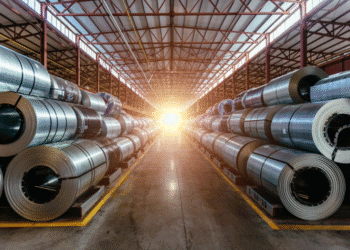DBT Bureau
Pune, 12 July 2025
One-third (32%) of global semiconductor production will be reliant on copper supply at risk from climate disruption by 2035, rising to 58% by 2050 if emissions do not decline, according to a new report from PwC, published today. The report finds that climate disruption risk poses a growing threat to the US$650 billion semiconductor industry, which is projected to exceed $1 trillion by 2030.
The report, the latest instalment of PwC’s Protecting People & Prosperity series, shows that copper mines, which require a steady water supply to function, face increasing risk from severe drought due to climate change. The analysis underlines the need for both copper exporters and semiconductor buyers to adapt their supply chains and practices if they are to manage the risks caused by climate disruption.
Glenn Burm, Global Semiconductors Leader, PwC South Korea, said: “Semiconductors are the hidden lifeblood of modern technology, embedded in everything from computers and phones to cars and washing machines. It’s hard to think of a company that doesn’t rely on semiconductors in some way. They underpin economic security, are vital to unlocking the potential of AI and integral to renewable energy. We can act now by understanding and managing risks to supply, including the physical risks of climate change. Around the world, companies are adapting by boosting water production, diversifying supply chains, and strengthening climate resilience. There’s great progress, but businesses can and should do more. As AI and other technologies drive digital transformation, the importance of securing critical commodities will only grow.”
Copper faces growing threat from climate disruption risk
Today, copper from only one country or territory that supplies the semiconductor industry – Chile – faces severe drought risks. However, within a decade, copper mines in the majority of the 17 countries that supply the semiconductor industry face severe drought risks.
As a result, more and more of the copper supply that semiconductor production relies on is at risk. As early as 2035, at least 34% of every semiconductor-making territory’s copper supply is projected to be at risk of drought disruption.
The resilience imperative: mitigating the risks of climate disruption to copper miners and semiconductor makers
Semiconductor makers and buyers face an urgent need to strengthen supply chain resilience. While businesses are taking action, and 68% of investors believe companies should increase action to de-risk their supply chain according to PwC’s 2024 Global Investor Survey, more needs to be done.
Across the value chain, businesses should approach climate disruption as a commercial risk that needs to be managed. The various actions stakeholders can, and in some cases are already taking, include:
- Copper miners increasing water supply by investing in desalination plants, improving water efficiency and recycling water. Some copper miners, especially in Chile, are already taking action to protect their operations from drought through desalination.
- Semiconductor makers increasingly recognising climate risks and taking steps, including material innovation, such as using alternative materials; efficiency improvements, i.e., producing more compact circuits; diversification of suppliers; and recycling and leveraging the circular economy.
- Business leaders should first identify climate risks throughout the value chain, managing these risks through tactics such as supplier diversification, moderating reliance on a given commodity, and collaborating with suppliers and other partners across the value chain to build climate resilience.
Lynne Baber, Global Deputy Sustainability Leader, PwC, said: “By uncovering hidden vulnerabilities across supply chains and operations, businesses can proactively shape resilience strategies that protect value at risk—whether financial, operational or reputational. Smarter climate adaptation unlocks agility, inspires innovation, and positions companies to lead in a more volatile world.”


















